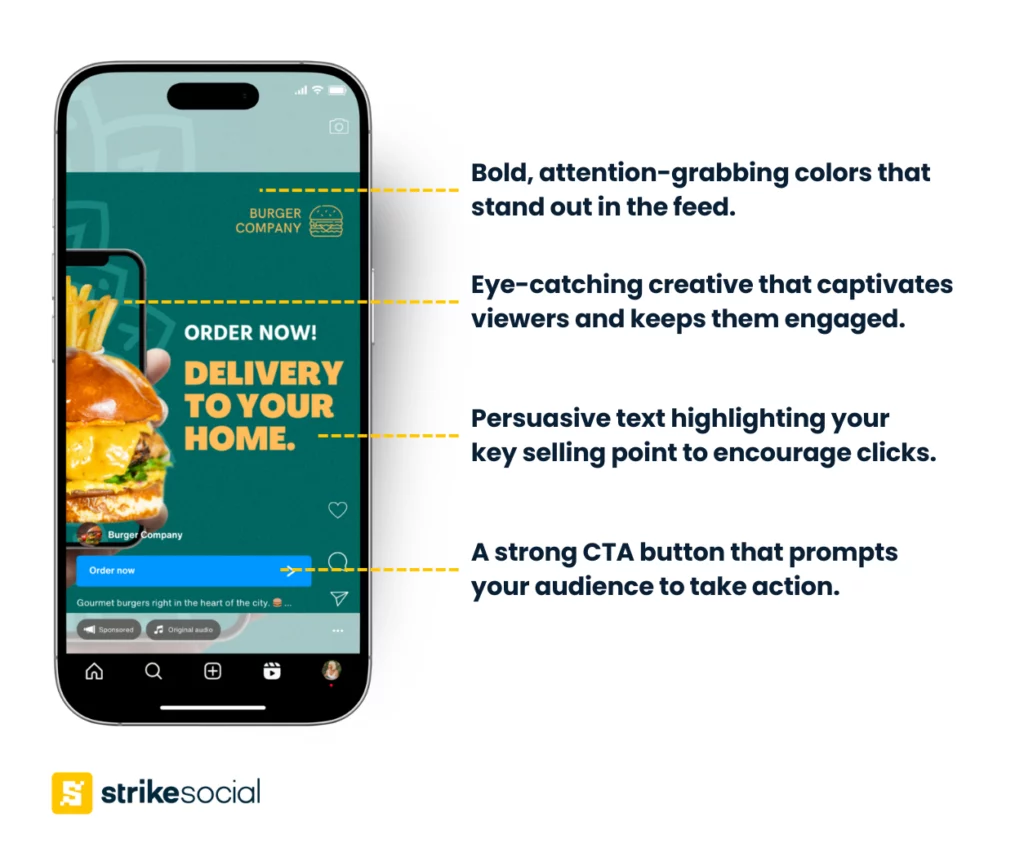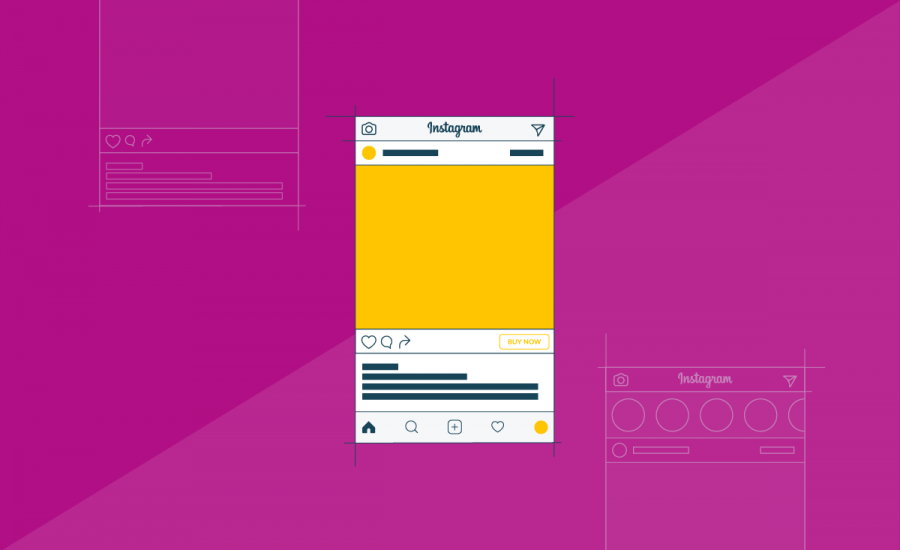Strike Overview
- Instagram’s direct response ads drive more clicks and conversions by providing a clear call-to-action (CTA) that tells your audience exactly what to do after seeing and engaging with your ad.
- Sweaty Betty, a global activewear brand, saw a 90% increase in add-to-carts with Instagram Reels ads featuring a direct “Shop Now” link. By combining engaging fit videos with a strong call-to-action, they successfully turned interest into action.
- Discover how to use Instagram’s direct response ads to improve lower-funnel performance, optimize engagement, and maximize results from your campaigns.
Jump to Section
This post was updated in February 2025 to provide you with the latest information.
Instagram’s Direct Response Ads: What They Are and How to Use Them
Did you know that Instagram’s direct response ads can lower your cost-per-action (CPA) by up to 21%?
An international fitness company proved this by running a 1.5-month Instagram ad campaign, generating 3,500 new signups with a simple but effective approach. They launched a direct response ad featuring an interactive poll asking users if they wanted 30 days of unlimited yoga streaming for free.
Not only did this ad encourage engagement through the poll, but it also included a direct sign-up page link, making it easy for interested users to convert. Through Instagram’s direct response ads, they successfully turned engagement into real memberships.
Want to achieve similar results? Let’s discover how direct response ads on Instagram work and how you can use them to drive conversions effectively.
What Are Direct Response Ads?
Instagram’s direct response ads are designed to drive immediate action. The moment a user sees your ad in their feed, they can take action without hesitation—whether it’s making a purchase, signing up, or leaving their information.
For performance-focused advertisers, these ads are a go-to strategy for converting intent into action. With strong call-to-action (CTA) buttons like “Shop Now” or “Sign Up”, users can seamlessly interact with your ad and be directed straight to your website, landing page, or an online store—eliminating unnecessary steps that could cause drop-offs.
Here’s what a direct response ad would look like:

It’s important not to confuse Instagram’s direct response ads with Instagram Direct Ads.
While direct response ads encourage immediate conversions, Instagram Direct Ads use a “Send Message” CTA, directing users to Instagram Direct Messenger. This format is better suited for businesses that rely on direct inquiries and conversational marketing.
How Instagram’s Direct Response Ads Work
Running direct response ads on Instagram is straightforward, but the key here is choosing the right call-to-action (CTA) to drive engagement.
These ads function just like regular Instagram ads, but what sets them apart is their ability to prompt immediate action. By selecting a CTA that aligns with your campaign goal, you guide users toward conversions with minimal friction.
Key Components of a Direct Response Ad
Ad Formats
You must choose the right Instagram advertising format to make Instagram’s direct response ads as effective as possible:
- Carousel Ads:
- Ideal for product collections, step-by-step tutorials, or storytelling.
- They allow up to 10 image or video cards, keeping users engaged as they swipe through.
- Stories Ads:
- Perfect for time-sensitive promotions like 24-hour flash sales
- Full-screen, vertical format grabs attention quickly
- Interactive elements like polls or countdown stickers boost engagement and urgency.
- Reels Ads:
- Best for product demos, influencer testimonials, or engaging short-form content.
- 63% of consumers say they are more likely to purchase a product if it’s recommended by a trusted influencer.
- Instant Experience Ads (Paired with Collection Ads):
- Creates immersive, mobile-first storefronts with shoppable product grids.
- Users can browse without leaving the Instagram app, making conversions seamless.
Further Reading

The Complete Instagram Ad Specs Guide
Before creating your direct response ads, review our guide to ensure your videos and images meet Instagram’s platform specifications. In addition, pay attention to safe zones to keep your text and calls-to-action clear of UI elements for maximum visibility.
Clear Calls-to-Action (CTA)
A strong call-to-action (CTA) it tells your audience exactly what to do next. To drive engagement and conversions, your CTA must be clear and reinforced in both your ad creative and CTA button.
Here are the best CTA options based on your campaign objective:
| Instagram Campaign Objective | Recommended CTAs |
|---|---|
| Engagement | Send message Contact us Watch more |
| Leads | Get offer Get quote Sign up Subscribe |
| App promotion | Install now Use app Download Play game |
| Sales | Order now Shop now Book now Get quote See menu |
Optimized Targeting
It’s important that for lower-funnel campaigns aimed at sales or conversions, your targeting should be more precise, apart from your usual audience demographic.
Imagine a sunglasses brand running ads for the 4th of July and summer season. A broad audience might include users aged 18 to 35, but a more strategic approach would focus on:
- Recent college graduates planning vacations;
- Users actively searching for holiday deals and travel essentials.
To further optimize targeting, here are key strategies to maximize conversions from your direct response ads:
- Retargeting:
- Create Custom Audiences of users who visited your website in the last 90 days or engaged with your video ads.
- Re-engage users who added products to their cart but didn’t complete checkout.
- Lookalike audiences:
- Use Advantage+ Audience to expand your reach and find high-intent users similar to your existing customers.
- Target users who resemble the profile of those who have previously converted.
- Exclusion lists:
- Avoid wasting ad spending by excluding past buyers (if they don’t need repeat purchases).
- Filter out irrelevant audiences that don’t align with your campaign goals.
Best Practices for Direct Response Ads on Instagram
- Choose your hashtags wisely. Hashtags can help increase your ad’s reach, but quality matters more than quantity. Instead of overloading your ad with 10+ hashtags, focus on the five most relevant and effective for your brand. Bring the less is more approach.
- Consistency is key. If you want your business to be as effective as possible, you’ll need to keep up with posting. You can’t post or run an ad campaign once every couple of months. Plan a consistent ad schedule that keeps your brand top-of-mind.
- Create scroll-stopping creatives. Instagram is a highly visual platform, meaning your ad creatives need to immediately grab attention. Use high-quality images or videos, incorporate bold colors, and hook users within the first few seconds. The goal is to trigger an instinctive reaction that makes them stop scrolling and take action.
- Inspire action. Your call-to-action needs to be tailored to your customer’s behaviors and preferences to get them to connect with your brand. If your copy sounds overly sales-driven, customers may likely skip your ad instead.
- Test and optimize regularly. Run A/B tests on different creatives, CTAs, and audience segments. Monitor your target Instagram ad metrics and adjust bids, targeting, and creatives accordingly to optimize performance.
Drive Results with Direct Response Ads
Instagram direct response ads are a great way to innovate in your social media marketing. Since Instagram has been shown to be more likely to encourage purchases, placing your direct response ads is a great idea to boost traffic and sales.
Success comes from strategic experimentation—testing different ad formats, creatives, and audience segments to find what resonates best with your target market. Apply the strategies covered in this guide, track your campaign performance, and continuously optimize to maximize results.








